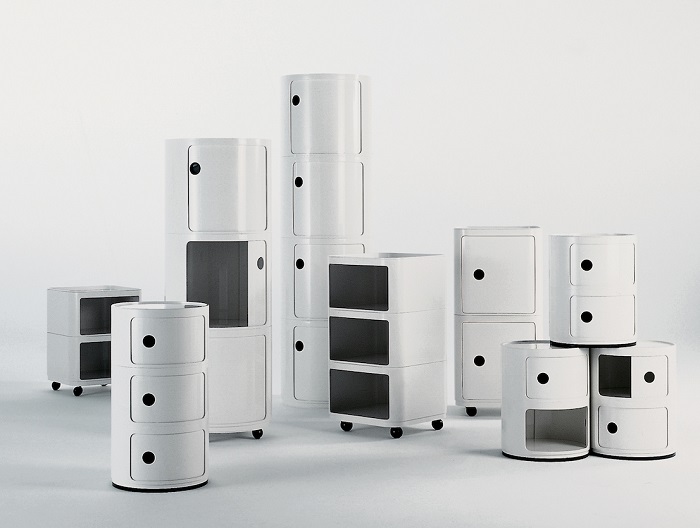
This photo illustrates the current production range of Kartell Componibili - short and tall square units (the latter with optional doors) as well as the varying diameters and heights of the cylindrical Componobili. For the larger modular containers, optional castors allow the resulting configuration to become mobile.
The 50th anniversary celebration of the Kartell Componibili has prompted Switch Modern to take a look back at this iconic design created by Anna Castelli Ferrieri. Designed as modular storage containers that simply stack/nest within each other where the consumer ultimately determines the resulting aesthetic and function of the form based upon the number of like elements purchased. Componobili was introduced in 1967 - these were square forms with rounded corners with one of the form's four sides open. There were two heights available; the larger version could even be outfitted with an optional hinged door. On the underside of each container are four holes into which castors can be snuggly fit in order to make a single piece or stacked group mobile. A lid was developed that can be used to create a surface atop any of the modular pieces - a single piece or a group. A profoundly clever design, the square Componobili could be stacked in clever and engaging ways - the use of different colors and orientations of container openings only added to the visual interest of assembling these modular elements. These were originally available in several colors - white, black, yellow, red, and orange. By the early 1970s, green and brown were available. And, as Kartell at this time was actually manufactured under license in different parts of the world, vivid colors like lime green and purple were available in Australia; neutral colors like mushroom/taupe and gray emerged in the United States. By the late 1980s, Kartell had pulled back its production to Italy and, over the ensuing decades, the color selection has been narrowed to continuously-produced white.
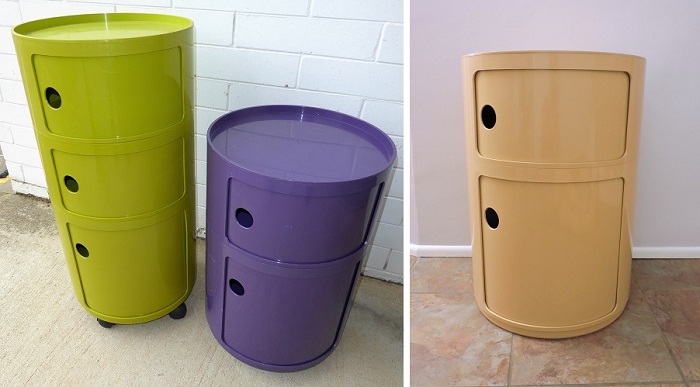
Left photo: vintage large round Componibili assemblages using the tall and short heights in lime green and purple were produced under license by Advanced Industries, Australia (credit: Jet Age). Right photo: a tall and short unit stacked together in a taupe color were produced under license in the United States by Beylerian (credit: Etsy).
Given the popularity and acclaim of the square version, Componobili's cyndrical cousin was introduced in 1969. Affectionately known as "Round Ups" in the United States, their drum-like shape sports a curved door with decorative cut-out hole allowing these to be easily slid open with one's finger - the door gliding along an integrated interior perimeter track. These were available in two sizes - 12" and 16" diameter respectively. The smaller version was originally available as a modular element - today these are seamed together in stacks of two or three with an integrated lid are popular in a bathroom, as bedside tables, or as impromptu storage next to a desk.
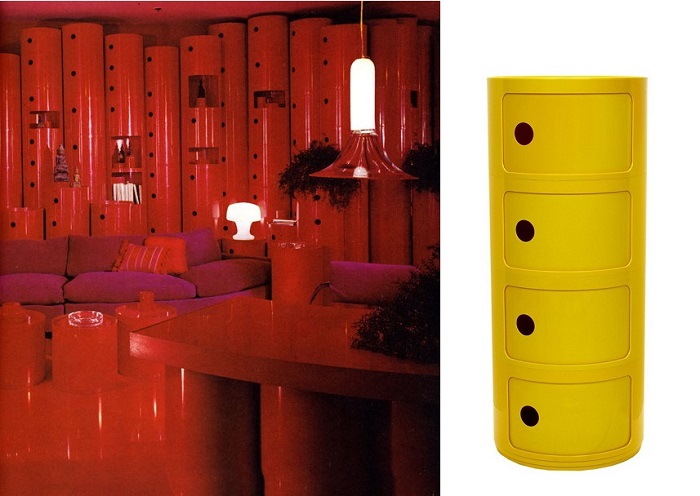
Left photo: A Bloomingdale's model room installation from the 1970s employs the large round Componibili in the short and tall heights shown in saturated red forming "towers" of escalating heights. Right photo: An original group of four small yellow Componibili that have been stacked with a lid. The earlier version of the smaller element design allowed for these to be purchased separately. Today this size is available as a "seamed" assemblage of a two-stack or three-stack of elements - each version with an integrated lid.
The larger 16" diameter element was available in two heights allowing a range of possibilities for function. Like the earlier square elements, the round Componibili could also be outfitted with optional castors. Again, with color selection, varying sizes, as well as doors that could be removed and placed within different containers (for example, with the purchase of an orange and red unit, a user could swap out the doors in each to create interesting arrangements with blocks of color). These large containers are now available in white as well as a matte silver finish that was introduced in 2000. Throughout the 21st century, Kartell has created special edition colors for the smaller diameter two-stack and three-stack Componibili that have included black and red, as well as metallic finishes of gold, copper, and silver. Over the years, customers have created remarkable aesthetics using the Kartell Componobili as a building block. Two stacked square Componobili with a lid and a material like cork or thin profile stone cut to nest within the lid thoroughly changes the look of the piece creating a textural juxtaposition.
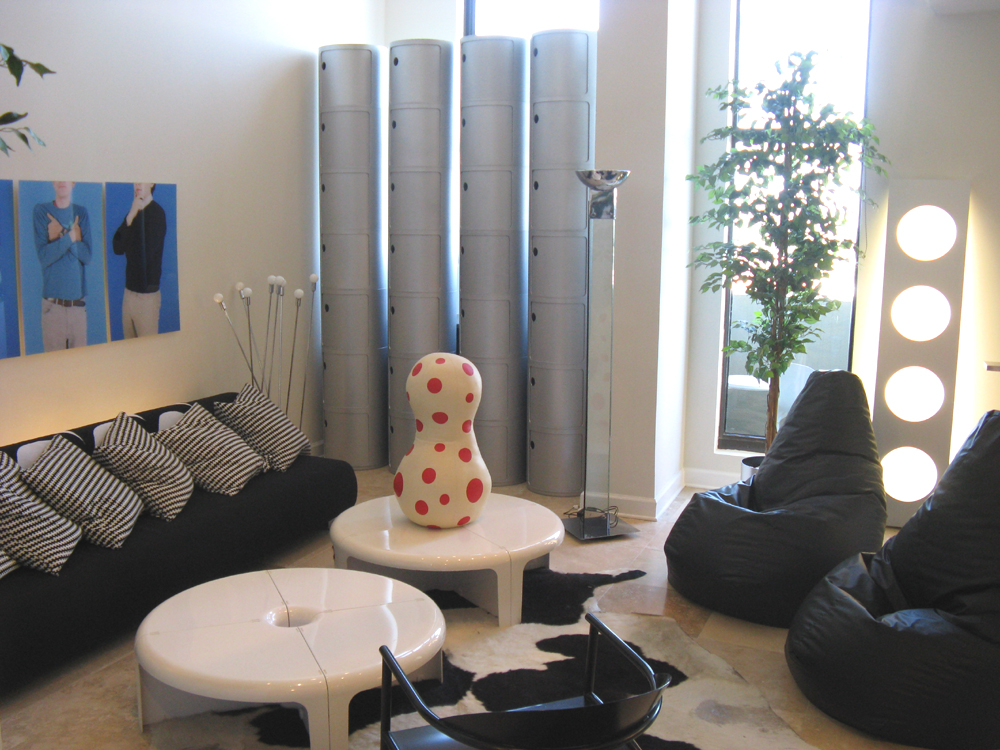
A total of 28 Kartell Componibili large round containers were used to create four "towers" that provide concealed storage in this space. (credit: switchmodern.com)
Kartell Componobili are usually seen stacked in heights that correlate with the height of a table or desk surface. However, the form when stacked five, six, or even seven high becomes an engaging tower. This "skyscraper" aesthetic was popularized through a Bloomingdale's model room in the early 1970s. This similar way of stacking as a façade of storage towers is illustrated in this Atlanta apartment with the large matte silver Componobili - these towers are over 9 feet tall.
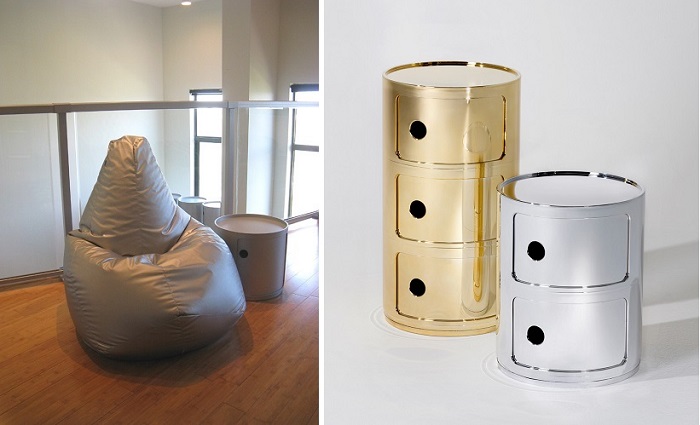
Left photo : A single large tub in matte silver with lid functions as an impromptu table/surface adjacent to a Zanotta Sacco chair (credit: switchmodern.com). Right photo: The smaller two-stack and three-stack Componibili in the luxe metallic finishes of chrome and gold.
Anna Castelli Ferrieri's Componibili design characterized the flexibility of designs in 1960s and 1970s whereby the user purchased elements and created a resulting object where function and aesthetic were ultimately determined by the assemblage of the purchased elements.
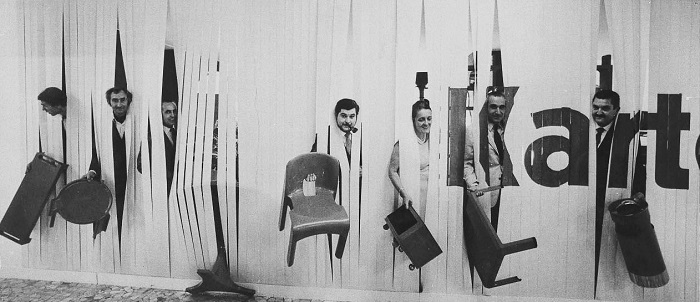
This photo was taken at the Kartell stand at the 1969 Salone del Mobile and features many of Kartell's most popular designers and their respective designs from the 1960s. From left to right, Olaf von Bohr holding a single shelf from his modular shelving system (1969); Giottino Stoppino holding a single table from his Model 4905/6/7 set of three nesting tables (1968); Ignazio Gardella with the base of his Model 4993 dining table (1966); Joe Colombo holding his Model 4867 chair (1967); Anna Castelli Ferrieri clutching an example of her Model 4970 short square Componibili with castors (1967); Alberto Rosselli holding the leg of one of his occasional tables (1967); and Gino Columbini holding an example of the designer's ubiquitous cylindrical containers used as wastebaskets and umbrella stands (1966).
Please contact us at 404-605-0196 or info@switchmodern.com to review the plethora of configurable options available with this iconic modular design.